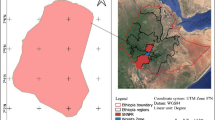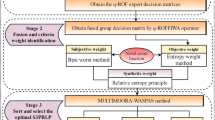Abstract
As an outranking-based multiple criteria decision-making method, the gained and lost dominance score (GLDS) method considers the loss aversion of the decision-makers who are more sensitive to the bad aspects of an alternative than the good ones. However, there are unresolved issues in the GLDS method, such as how to deal with numerical decision information, how to model the personalized risk tolerance attitudes of decision-makers, and how to identify soft preference relations and incomparability relations between alternatives. This study aims to address these issues and proposes an enhanced GLDS method with conflict analysis. Firstly, we define the possibility degree of an alternative to achieve the goal under each criterion considering the nonlinear cognition of decision-makers. To reflect the tolerance of a decision maker for the worst performance of an alternative, we introduce a parameter in the aggregation function to weigh the gained and lost dominance scores of each alternative. In addition, a conflict analysis framework is constructed to distinguish the preference, indifference, and incomparability relations between alternatives. Based on the above improvements, an enhanced GLDS method with conflict analysis is developed. We then demonstrate the applicability of the enhanced GLDS method by a case study about evaluating the green economy development levels of 21 cities in Sichuan, China. The comparative analysis of the case study shows that the proposed method has superiority in satisfying personalized requirements of decision-makers.







Similar content being viewed by others
Notes
The full name of each method is: TOPSIS—Technique for order preference by similarity to ideal solution, VIKOR—Vlsekriterijumska optimizacija I kompromisno resenje in Serbian, meaning multi-criteria optimization with compromise solution, PROMETHEE—Preference ranking organization method for enrichment evaluations, ELECTRE—Elimination et choix traduisant la realité in French, meaning elimination and choice expressing the reality.
Scientific Development and Economic Sustainable Development Research Base of Beijing Normal University, Green Economy and Economic Sustainable Development Research Base of Southwestern University of Finance and Economics, China Economic Monitoring and Analysis Center of National Bureau of Statistics. China green development index report 2016-Regional comparison. Beijing: Beijing Normal University Press, 2016.
References
Aggarwal, M., & Fallah, T. A. (2019). Modelling human decision behaviour with preference learning. INFORMS Journal on Computing, 31(2), 318–334.
Barbier, E. (2012). The green economy post rio+20. Science, 338(6109), 887–888.
Basak, S., Shapiro, A., & Tepla, L. (2006). Risk management with benchmarking. Management Science, 52(4), 542–557.
Bashir, Z., Ali, J., & Rashid, T. (2020). Consensus-based robust decision making methods under a novel study of probabilistic uncertain linguistic information and their application in Forex investment. Artificial Intelligence Review. https://doi.org/10.1007/s10462-020-09900-y
Bourguignon, B., & Massart, D. L. (1994). The ORESTE method for multicriteria decision making in experimental chemistry. Chemometrics & Intelligent Laboratory Systems, 22(2), 241–256.
Bouyssou, D., & Pirlot, M. (2009). An axiomatic analysis of concordance–discordance relations. European Journal of Operational Research, 199(2), 468–477.
Brans, J.P. & Mareschal, B. (2005). Promethee methods. Multiple criteria decision analysis: State of the art surveys (pp. 163–186). Springer.
Brans, J. P., & Vincke, P. (1985). A preference ranking organisation method (The PROMETHEE method for multiple criteria decision making). Management Science, 31(6), 647–656.
Cinelli, M., Kadzinski, M., Gonzalez. & Slowinski, R. (2020). How to support the application of multiple criteria decision analysis? Let us start with a comprehensive taxonomy. Omega. https://doi.org/10.1016/j.omega.2020.102261.
Dinçer, S. E. (2011). The structural analysis of key indicators of Turkish manufacturing industry: ORESTE and MAPPAC applications. European Journal of Scientific Research, 60(1), 6–18.
Govindan, E., & Jepsen, M. B. (2016). ELECTRE: A comprehensive literature review on methodologies and applications. European Journal of Operational Research, 250(1), 1–29.
Govindan, K., & Sivakumar, R. (2016). Green supplier selection and order allocation in a low-carbon paper industry: Integrated multi-criteria heterogeneous decision-making and multi-objective linear programming approaches. Annals of Operations Research, 238(1–2), 243–276.
Hwang, C. L., & Yoon, K. (1981). Multiple attribute decision making-methods and applications: A state-of-the-art survey. Springer.
Kahneman, D., & Tversky, A. (1979). Prospect theory: An analysis of decision under risk. Econometrica, 47(2), 263–291.
Li, W. W., Wang, W. P., Wang, Y., & Ali, M. (2018). Historical growth in total factor carbon productivity of the Chinese industry—a comprehensive analysis. Journal of Cleaner Production, 170, 471–485.
Loiseau, E., Saikku, L., Antikainen, R., Droste, N., Hansjurgens, B., Pitkanen, K., Leskinen, P., Kuikman, P., & Thomsen, M. (2016). Green economy and related concepts: An overview. Journal of Cleaner Production, 139, 361–371.
Lootsma, F. A. (1993). Scale sensitivity in the multiplicative AHP and SMART. Journal of Multi-Criteria Decision Analysis, 2(2), 87–110.
Markle, A., Wu, G., White, R., & Sackett, A. (2018). Goals as reference points in marathon running: A novel test of reference dependence. Journal of Risk and Uncertainty, 56(1), 19–50.
Opricovic, S. (1998). Multicriteria Optimization of Civil Engineering Systems. Faculty of Civil Engineering, Belgrade.
Opricovic, S., & Tzeng, G. H. (2004). Compromise solution by MCDM methods: A comparative analysis of VIKOR and TOPSIS. European Journal of Operational Research, 156(2), 445–455.
Pang, Q., Wang, H., & Xu, Z. S. (2016). Probabilistic linguistic term sets in multi-attribute group decision making. Information Sciences, 369, 128–143.
Rezaei, J. (2018). Piecewise linear value functions for multi-criteria decision-making. Expert Systems with Applications, 98, 43–56.
Roubens, M. (1982). Preference relations on actions and criteria in multicriteria decision making. European Journal of Operational Research, 10(1), 51–55.
Roy, B. (1968). Classement et choix en presence de points de vue multiples (La methode ELECTRE). Revue Francaise D Informatique De Recherche Operationnelle, 2(8), 57–75.
Sobrie, O., Gillis, N., Mousseau, V., & Pirlot, M. (2018). UTA-poly and UTA-splines: Additive value functions with polynomial marginals. European Journal of Operational Research, 264(2), 405–418.
Wang, M. X., Zhao, H. H., Cui, J. X., Fan, D., Lv, B., Wang, G., Li, Z. H., & Zhou, G. J. (2018). Evaluating green development level of nine cities within the Pearl River Delta, China. Journal of Cleaner Production, 174, 315–323.
Wang, W. Z., Liu, X. W., & Liu, S. L. (2020). Failure mode and effect analysis for machine tool risk analysis using extended gained and lost dominance score method. IEEE Transactions on Reliability, 69(3), 954–967.
Wątróbski, J., Jankowski, J., Ziemba, P., Karczmarczyk, A., & Zioło, M. (2019). Generalised framework for multi-criteria method selection. Omega, 86, 107–124.
Weber, E.H. (1850). Der Tastsinn und das Gemeingefuhl. In Handwo¨rterbuch der Physiologie (Vol. 3). Braunschweig.
Weingarten, E., Bhatia, S., & Mellers, B. (2019). Multiple goals as reference points: One failure makes everything else feel worse. Management Science, 65(7), 3337–3352.
Wu, X. L., & Liao, H. C. (2019). A consensus based probabilistic linguistic gained and lost dominance sore method. European Journal of Operational Research, 272(3), 1017–1027.
Wu, C. Y., Guo, L. L., & Yu, J. T. (2017). Evaluation model and empirical study of regional green growth system based on TOPSIS-Grey relational analysis. Management Review, 29(1), 228–239.
Wu, D. D., Wang, Y. H., & Qian, W. Y. (2020). Efficiency evaluation and dynamic evolution of China’s regional green economy: A method based on the Super-PEBM model and DEA window analysis. Journal of Cleaner Production, 264, 121630. https://doi.org/10.1016/j.jclepro.2020.121630
Yi, H. T., & Liu, Y. (2015). Green economy in China: Regional variations and policy drivers. Global Environmental Change, 31, 11–19.
Zhou, W., & Xu, Z. S. (2016). Generalized asymmetric linguistic term set and its application to qualitative decision making involving risk appetites. European Journal of Operational Research, 254(2), 610–621.
Acknowledgements
The work was supported by the National Natural Science Foundation of China (71771156, 71971145).
Author information
Authors and Affiliations
Corresponding author
Additional information
Publisher's Note
Springer Nature remains neutral with regard to jurisdictional claims in published maps and institutional affiliations.
Appendix
Appendix
See Tables 3, 4, 5, 6, 7, 8 and 9.
Rights and permissions
About this article
Cite this article
Wu, X., Liao, H. A gained and lost dominance score method with conflict analysis for green economy development evaluation. Ann Oper Res 316, 623–655 (2022). https://doi.org/10.1007/s10479-021-04200-2
Accepted:
Published:
Issue Date:
DOI: https://doi.org/10.1007/s10479-021-04200-2




